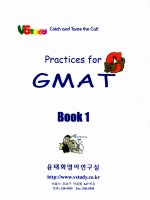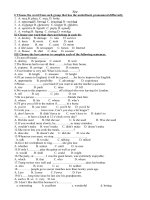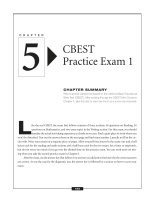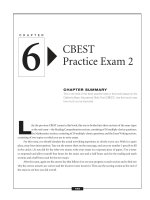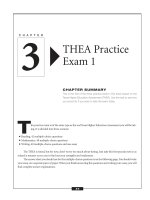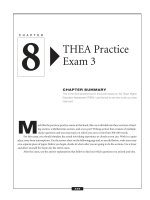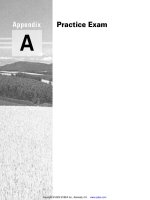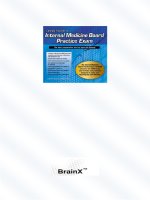CBEST Practice Exam 2
Bạn đang xem bản rút gọn của tài liệu. Xem và tải ngay bản đầy đủ của tài liệu tại đây (254.98 KB, 40 trang )
L
ike the previous CBEST exams in this book, this one is divided into three sections of the same types
as the real exam—the Reading Comprehension section, consisting of 50 multiple-choice questions;
the Mathematics section, consisting of 50 multiple-choice questions; and the Essay Writing section,
consisting of two topics on which you are to write essays.
For this exam, you should simulate the actual test-taking experience as closely as you can. Work in a quiet
place, away from interruptions. Tear out the answer sheet on the next page, and use your number 2 pencils to fill
in the circles. (As you did for the other two exams, write your essays on a separate piece of paper.) Use a timer
or stopwatch and allow yourself four hours for the exam: one-and-a-half hours each for the reading and math
sections and a half-hour each for the two essays.
After the exam, again use the answer key that follows it to see your progress on each section and to find out
why the correct answers are correct and the incorrect ones incorrect. Then use the scoring section at the end of
the exam to see how you did overall.
CHAPTER
CBEST
Practice Exam 2
CHAPTER SUMMARY
This is the third of the three practice tests in this book based on the
California Basic Educational Skills Test (CBEST). Use this test to see
how much you’ve improved.
6
195
–
LEARNINGEXPRESS CALIFORNIA BASIC EDUCATIONAL SKILLS TEST ANSWER SHEET
–
197
1. abcde
2. abcde
3. abcde
4. abcde
5. abcde
6. abcde
7. abcde
8. abcde
9. abcde
10. abcde
11. abcde
12. abcde
13. abcde
14. abcde
15. abcde
16. abcde
17. abcde
18. abcde
19. abcde
20. abcde
21. abcde
22. abcde
23. abcde
24. abcde
25. abcde
26. abcde
27. abcde
28. abcde
29. abcde
30. abcde
31. abcde
32. abcde
33. abcde
34. abcde
35. abcde
36. abcde
37. abcde
38. abcde
39. abcde
40. abcde
41. abcde
42. abcde
43. abcde
44. abcde
45. abcde
46. abcde
47. abcde
48. abcde
49. abcde
50. abcde
1. abcde
2. abcde
3. abcde
4. abcde
5. abcde
6. abcde
7. abcde
8. abcde
9. abcde
10. abcde
11. abcde
12. abcde
13. abcde
14. abcde
15. abcde
16. abcde
17. abcde
18. abcde
19. abcde
20. abcde
21. abcde
22. abcde
23. abcde
24. abcde
25. abcde
26. abcde
27. abcde
28. abcde
29. abcde
30. abcde
31. abcde
32. abcde
33. abcde
34. abcde
35. abcde
36. abcde
37. abcde
38. abcde
39. abcde
40. abcde
41. abcde
42. abcde
43. abcde
44. abcde
45. abcde
46. abcde
47. abcde
48. abcde
49. abcde
50. abcde
Section 1: Reading Comprehension
Section 2: Mathematics
Section 1: Reading Comprehension
Answer questions 1–8 on the basis of the following
passage.
(1) Milton Hershey was born near the small village
of Derry Church, Pennsylvania, in 1857. It was a
modest beginning that did not foretell his later pop-
ularity. Milton only attended school through the
fourth grade; at that point, he was apprenticed to a
printer in a nearby town. Fortunately for all choco-
late lovers, Milton did not excel as a printer. After a
while, he left the printing business and was appren-
ticed to a Lancaster, Pennsylvania, candy maker. It
was apparent he had f
ound his calling in life and, at
the age of eighteen, he opened his own candy store
in Philadelphia. In spite of his talents as a candy
maker, the shop failed after six years.
(2) Milton Hershey’s fans today may be surprised
to learn that his first candy success came with the
manufacture of caramel. After the failure of his
Philadelphia store, Milton headed for Denver,
where he learned the art of caramel making. There
he took a job with a local manufacturer who
insisted on using fresh milk in making his caramels;
Milton saw that this made the caramels especially
tasty. After a time in Denver, he once again
attempted to open his own candy-making busi-
nesses, in Chicago, New Orleans, and New York
City. Finally, in 1886, he went to Lancaster, Penn-
sylvania, where he raised the money necessary to try
again. This company—the Lancaster Caramel
Company—made Milton’s reputation as a master
candy maker.
(3) In 1893, Milton attended the Chicago Inter-
national Exposition, where he saw a display of Ger-
man chocolate-making implements. Captivated by
the equipment, he purchased it for his Lancaster
candy factory and began producing chocolate,
which he used for coating his caramels. By the next
year, production had grown to include cocoa, sweet
chocolate, and baking chocolate. The Hershey
Chocolate company was born in 1894 as a s
ub-
sidiary of the Lancaster Caramel Company. Six
years later, Milton sold the caramel company, but
retained the rights, and the equipment, to make
chocolate. He believed that a large market of
chocolate consumers was waiting for someone to
produce reasonably priced candy. He was right.
(4) Milton Hershey returned to the village where
he had been born, in the heart of dairy country, and
opened his chocolate-manufacturing plant. With
access to all the fresh milk he needed, he began pro-
ducing the finest milk chocolate. The plant that
opened in a small Pennsylvania village in 1905 is
today the largest chocolate factory in the world. The
confections created at this facility are favorites in the
U.S. and internationally.
(5) The area where the factory is located is now
known as Hershey, Pennsylvania. Within the first
decades of its existence, the town thrived, as did the
chocolate business. A bank, a school, churches, a
department store, even a park and a trolley system
all appeared in short order. Soon, the town even had
a zoo. Today, a visit to the area reveals the Hershey
Medical Center, Milton Hershey School, and Her-
shey’s Chocolate World, a theme park where visitors
are greeted by a giant Reese’s Peanut Butter Cup. All
of these things—and a huge number of happy
chocolate lovers—were made possible because a
caramel maker visited the Chicago Exposition of
1893!
–
CBEST PRACTICE EXAM 2
–
199
1. The writer’s main purpose in this passage is to
a. recount the founding of the Hershey Choco-
late Company.
b. describe the process of manufacturing choco-
late.
c. compare the popularity of chocolate to other
candies.
d. explain how apprenticeships work.
e. persuade readers to visit Hershey,
Pennsylvania.
2. As it is used in paragraph 1, the underlined
phrase found his calling in life most nearly means
a. became educated.
b. discovered a vocation.
c. was a talented person.
d. called on other people to help him.
e. had good luck.
3. Which of the following statements is supported
by information in the passage?
a. Chocolate is popular in every country in the
world.
b. The Hershey Chocolate Company’s factory is
near Derry Church, Pennsylvania.
c. Chocolate had never been manufactured in
the United States before Milton Hershey did
it.
d. The Hershey Chocolate Company is run by
Milton Hershey’s children.
e. The Hershey Chocolate Company has
branches in Chicago, New Orleans, and New
Yor k C i t y.
4. Which of the following words best describes Mil-
ton Hershey’s character, as he is presented in the
passage?
a. defective
b. determined
c. carefree
d. cautious
e. greedy
5. According to the passage, Milton Hershey first
began to produce chocolate in order to
a. make cocoa and baking chocolate.
b. save his caramel company from bankruptcy.
c. make chocolate-covered caramels.
d. attend the Chicago International Exposition.
e. found a new town.
6. Which of the following best defines the under-
lined word subsidiary as used in paragraph 3?
a. a company that is in financial trouble
b. a company founded to compete with another
company
c. a company that is not incorporated
d. a company controlled by another company
e. a company owned by one person
7. The passage implies that Hershey opened his first
chocolate company in
a. Chicago.
b. Denver.
c. Philadelphia.
d. Lancaster.
e. Derry Church.
8.
The author most likely included the information
in paragraph 5 in order to show that
a. Hershey’s chocolate factory was so successful
that a whole town was built around it.
b. people all over the world have become tourists
in Hershey, Pennsylvania.
c. Hershey’s chocolate factory has now become a
successful theme park.
d. Hershey moved back to the town where he
was born.
e. the Hershey Chocolate Company manufac-
tures both chocolate and caramel.
Answer questions 9–10 on the basis of the follow-
ing passage.
An ecosystem is a group of animals and plants liv-
ing in a specific region and interacting with one
–
CBEST PRACTICE EXAM 2
–
200
another and with their physical environment.
Ecosystems include physical and chemical compo-
nents, such as soils, water, and nutrients, that sup-
port the organisms living there. These organisms
may range from large animals to microscopic bac-
teria. Ecosystems also can be thought of as the inter-
actions among all organisms in a given habitat; for
instance, one species may serve as food for another.
People are part of the ecosystems where they live
and work. Human activities can harm or destroy
local ecosystems unless actions such as land devel-
opment for housing or businesses are carefully
planned to conserve and sustain the ecology of the
area. An important part of ecosystem management
involves finding ways to protect and enhance eco-
nomic and social well-being while protecting local
ecosystems.
9. What is the main idea of the passage?
a. An ecosystem is a community that includes
animals, plants, and microscopic bacteria.
b. Human activities harm or destroy local
ecosystems, no matter how careful we may be.
c. In managing the ecology of an area, it is
important to protect both human interests
and the interests of other members of local
ecosystems.
d. People should remember that they are a part
of the ecosystems where they live and work.
e. Ecosystems include both living and non-living
things.
10. An ecosystem can most accurately be defined
as a
a. geographical area.
b. community.
c. habitat.
d. protected environment.
e. region.
Answer questions 11–12 on the basis of the follow-
ing passage.
The city has distributed standardized recycling con-
tainers to all households; the containers are marked
with directions that read: “We would prefer that you
use this new container as your primary recycling
container. Additional recycling containers may be
purchased from the city.”
11. According to the directions, each household
a. may only use one recycling container.
b. must use the new recycling container.
c. should use the new recycling container.
d. must buy a new recycling container.
e. should pick up the new recycling container.
12. According to the directions, which of the follow-
ing is true about the new containers?
a. The new containers are better than other con-
tainers.
b. Households may use only the new containers
for recyclable items.
c. The new containers hold more than the old
containers did.
d. Households may use other containers besides
the new ones if they wish.
e. Additional containers can be delivered at no
charge.
Answer questions 13–16 on the basis of the follow-
ing passage.
In Ralph Waldo Emerson’s view, although indi-
vidual consciousness will eventually be lost, every liv-
ing thing is part of the blessed Unity, part of the
transcendent “over-soul” which is the universe. And so,
in the main body of his philosophy, Emerson accepts
the indifference of Nature to the individual life, and
does not struggle against it. His acceptance of Nature
as tending toward overall unity and good in spite of
her indifference to the individual is curiously and iron-
ically akin to the Puritan acceptance of the doctrine of
–
CBEST PRACTICE EXAM 2
–
201
Divine Election. In his “Personal Narrative” Jonathan
Edwards writes that he finally has “a delightful convic-
tion” of the doctrine of God’s sovereignty, of God’s
choosing according to His divine and arbitrary will,
“whom he would to eternal life, and rejecting whom he
pleased ....”He writes that the doctrine had formerly
seemed ___________ to him; however, it had finally
come to seem “exceedingly pleasant, bright, and
sweet.” In “Fate,” Emerson writes that “Nature will not
mind drowning a man or a woman, but swallows your
ship like a grain of dust,” but that “the central intention
of Nature [is] harmony and joy. Let us build altars to
the Beautiful Necessity....”
13. Which of the following statements would LEAST
effectively support the view of both Emerson and
Edwards toward the nature of the universe?
a. God notices the fall of a sparrow.
b. God is all-powerful and all-wise.
c. The universe is a harmonious place.
d. Nature is beautiful and good.
e. One should accept the universal plan.
14. Which of the following best describes the main
idea of the passage?
a. As philosophers reflecting on the nature of the
universe, Ralph Waldo Emerson and Jonathan
Edwards are ironically akin to one another.
b. Ralph Waldo Emerson believes that nature is
indifferent to individuals; on the other hand,
Jonathan Edwards believes God makes deci-
sions about individuals, but based on His
desires.
c. Ralph Waldo Emerson believes in a world
ruled by the transcendent oversoul of Nature,
whereas Jonathan Edwards believes in a world
ruled by a sovereign God.
d. Ralph Waldo Emerson believes that individual
consciousness will be lost after death, whereas
Jonathan Edwards believes that the soul will
go to heaven or hell.
e. Ralph Waldo Emerson’s acceptance of
Nature’s indifference to the individual is ironi-
cally similar to Jonathan Edwards’ acceptance
of the doctrine of Divine Election.
15. Which of the following terms best defines the
doctrine of Divine Election as discussed in the
passage?
a. God’s power
b. the soul’s redemption
c. eternal damnation
d. predestined salvation
e. a state of grace
16. In the context of the passage, which of the fol-
lowing words would best fit in the blank?
a. loving
b. just
c. horrible
d. imperious
e. satisfying
Answer question 17 on the basis of the following
passage.
Authentic Dhurrie rugs are hand-woven in India.
Today, they are usually made of wool, but they are
descendants of cotton floor- and bed-coverings. In
fact, the name Dhurrie comes from the Indian word
dari, which means threads of cotton. The rugs are
noted for their soft colors and their varieties of design
and make a stunning focal point for any living room or
dining room.
17. Which of the following is the most likely
intended audience for the passage?
a. people who are planning a trip to India
b. people studying traditional Indian culture
c. people who are studying Indian domestic cus-
toms
d. people learning to operate a rug loom
e. people who enjoy interior decorating
–
CBEST PRACTICE EXAM 2
–
202
Answer questions 18 and 19 on the basis of the fol-
lowing passage.
A healthy diet with proper nutrition is essential
for maintaining good overall health. Since vitamins
were discovered earlier in this century, people have
routinely been taking vitamin supplements for this
purpose. The Recommended Dietary Allowance
(RDA) is a frequently used nutritional standard for
maintaining optimal health. The RDA specifies the
recommended amount of a number of nutrients for
people of both sexes and in many different age
groups. The National Research Council’s Committee
on Diet and Health has proposed a definition of the
RDA to be that amount of a nutrient which meets the
needs of 98 percent of the population.
The RDA approach ______________________.
First, it is based on the assumption that it is possible to
accurately define nutritional requirements for a given
group. However, individual nutritional requirements
can vary widely within each group. The efficiency with
which a person converts food intake into nutrients can
also vary widely. Certain foods when eaten in combi-
nation actually prevent the absorption of nutrients.
For example, spinach combined with milk reduces the
amount of calcium available to the body from the
milk. Also, the RDA approach specifies a different
dietary requirement for each age and sex; however, it is
clearly unrealistic to expect a homemaker to prepare a
different menu for each family member. Still, although
we cannot rely solely upon RDA to ensure our overall
long-term health, it can be a useful guide so long as its
limitations are recognized.
18. Which of the following would best fit in the
blank in the first sentence of paragraph two?
a. is based on studies by respected nutritionists
b. has a number of shortcomings
c. has been debunked in the last few years
d. is full of holes
e. is constantly being refined
19. With which of the following would the author
most likely agree?
a. The RDA approach should be replaced by a
more realistic nutritional guide.
b. The RDA approach should be supplemented
with more specific nutritional guides.
c. In spite of its flaws, the RDA approach is defi-
nitely the best guide to good nutrition.
d. The RDA approach is most suitable for a large
family.
e. The RDA approach is too complicated for
most consumers.
Answer questions 20–22 on the basis of the follow-
ing passage.
It has been more than twenty-five years since the
National Aeronautic and Space Administration
(NASA) last sent a craft to land on the moon. The
Lunar Prospector took off in January of 1998, in the
first moon shot since astronauts last walked on the
moon in 1972. This time, the moon-traveller is only a
low-cost robot, who will spend a year on the surface of
the moon, collecting minerals and ice.
Unlike the moon shots of the 1960s and 1970s,
Lunar Prospector does not carry a camera, so the
American public will not get to see new pictures of the
moon’s surface. ______________________________.
Scientists are anxious for the results of one exploration
in particular—that done by the neutron spectrometer.
Using this instrument, Prospector will examine the
moon’s poles, searching for signs of water ice. There
has long been speculation that frozen water from
comets may have accumulated in craters at one of the
moon’s poles and may still be there, as this pole is per-
manently shielded from the sun. The neutron spec-
trometer seeks out the hydrogen atoms in water and
can detect the presence of as little as one cup of water
in a cubic yard of soil.
–
CBEST PRACTICE EXAM 2
–
203
20. Which sentence, if inserted into the blank line in
the second paragraph, would be most consistent
with the writer’s purpose and intended
audience?
a. You won’t, therefore, be able to see if the sur-
face of the moon has changed much in thirty
years.
b. Instead, Prospector carries instruments that
will map the make-up of the entire surface of
the moon.
c. I don’t believe that new pictures would prove
very interesting, anyway.
d. However, the topography of the lunar terrain
retains a mundane familiarity that is not con-
sistent with the nature of NASA’s raison d’etre
and will contribute little to advancements vis
a vis missions such as Sojourner.
e. Entertainment of the public does not justify
the enormous cost of space exploration.
21. Which of the following is the best meaning of
the word “speculation” as it is used in the second
paragraph of the passage?
a. a theory
b. an investment
c. a vision
d. an image
e. a process
22. Which of the following kinds of publications
would most likely contain this passage?
a. an astrophysics text book
b. a history text book
c. a collection of personal essays
d. a general circulation magazine
e. an internal NASA memo
Answer questions 23–26 on the basis of the follow-
ing passage.
O’Connell Street is the main thoroughfare of
Dublin City. Although it is not a particularly long
street, Dubliners will tell the visitor proudly that it is
the widest street in all of Europe. This claim usually
meets with protests, especially from French tourists,
claiming the Champs Elysees of Paris as Europe’s
widest street. But the witty Dubliner will not relin-
quish bragging rights easily and will trump the French
visitor with a fine distinction: the Champs Elysees is a
boulevard; O’Connell is a street.
Divided by several important monuments run-
ning the length of its center, the street is named for
Daniel O’Connell, an Irish patriot. _______________
____________________________. O’Connell stands
high above the unhurried crowds of shoppers, business
people, and students on a sturdy column, surrounded
by four serene angels seated at each corner of the mon-
ument’s base. Further up the street is the famous Gen-
eral Post Office that the locals affectionately call “the
GPO.” During the 1916 rebellion, the GPO was taken
over and occupied by the Irish rebels to British rule,
sparking weeks of armed combat in the city’s center. To
this day, the angels of O’Connell’s monument bear the
marks of the fighting: one sits reading calmly, appar-
ently unaware of the bullet hole dimpling her upper
arm; another, reaching out to stroke the ears of a huge
bronze Irish wolfhound, has survived what should be
a mortal wound to her heart.
23. Which of the following would be the best title
for this passage?
a. Dublin’s Famous Monuments
b. The Irish Take Pride in Their Capital City
c. The Widest Street in Europe
d. Sights and History on Dublin’s O’Connell
Street
e. Tourism in Dublin
–
CBEST PRACTICE EXAM 2
–
204
24. Which sentence, if inserted in the blank space
above, would be the most correct and contribute
the most pertinent information to that
paragraph?
a. His monument stands at the lower end of the
road, the end closest to the river Liffey that
bisects Dublin.
b. Other monuments along the street include
statues to Charles Parnell, Anna Livia Plura-
belle, and James Joyce.
c. Dublin tourist buses leave from this site every
twenty minutes.
d. Daniel O’Connell was an important Irish
nationalist, who died before the 1916 rebel-
lion.
e. We can see his monument standing in lower
O’Connell Street facing the Liffey River.
25. What is the best definition for the word “trump”
as it is used in the first paragraph of the passage?
a. to trumpet loudly, to blare or drown out
b. to trample
c. to get the better of by using a key or hidden
resource
d. to devise a fraud, to employ trickery
e. to use a particular suit of cards
26. With which of the following statements about
the people of Dublin would the author of the
passage most likely agree?
a. They are proud of their history but lack
industry.
b. They are playful and tricky.
c. They are rebellious and do not like tourists.
d. They are witty and relaxed.
e. They are unaware of their history.
Answer questions 27–29 on the basis of the follow-
ing passage.
In 1899, Czar Nicholas II of Russia invited the
nations of the world to a conference at The Hague.
This conference—and a follow-up organized by
Theodore Roosevelt in 1907—ushered in a period of
vigorous growth in international law. This growth was
in response to several factors, not least of which was
the increasing potential for destruction of modern
warfare. The recently concluded Civil War in the
United States made this potential clear.
During this growth, the subjects of international
law were almost exclusively restricted to the relation-
ships that countries had with one another. Issues of
trade and warfare dominated both the disputes and the
agreements of the period. _________, the develop-
ments of this period paved the way for further expan-
sion of international law, which has occurred in the last
several years. ________, organizations such as the
United Nations and the International Court of Justice
are greatly concerned not only with the way countries
deal with one another, but the ways in which they treat
their own citizens.
27. Which words or phrases, if inserted in order into
the blanks in the passage, would help the reader
understand the sequence of the author’s ideas?
a. Therefore; In addition
b. However; Now
c. Furthermore; Yet
d. Even if; On the other hand
e. As a result; Meanwhile
–
CBEST PRACTICE EXAM 2
–
205
28. According to the passage, what was the impact of
the U.S. Civil War on the development of inter-
national law?
a. It encouraged the United States to join the
international community.
b. It allowed armaments manufacturers to test
new weapons.
c. It diminished the influence of the United
States internationally.
d. It resulted in the suspension of agriculture
exports from Southern states.
e. It highlighted the increasing destructive capa-
bilities of modern warfare.
29. Which of the following is the best meaning of
the phrase ushered in as it is used in the passage?
a. escorted
b. progressed
c. guarded
d. heralded
e. conducted
Answer questions 30–32 on the basis of the follow-
ing passage.
Emperor Charlemagne of the Franks was
crowned in 800 A.D. The Frankish Empire at that time
extended over what is now Germany, Italy, and France.
Charlemagne died in 814, but his brief reign marked
the dawn of a distinctly European culture. The artists
and thinkers that helped create this European civiliza-
tion drew on the ancient texts of the Germanic, Celtic,
Greek, Roman, Hebrew, and Christian worlds.
__________________________________________.
These mores in turn laid the groundwork for the laws,
customs, and even attitudes of today’s Europeans.
30. According to the passage, for how many years
was Charlemagne Emperor of the Franks?
a. fourteen years
b. fifteen years
c. thirteen years
d. sixteen years
e. twelve years
31. Which of the following is the best meaning of
the word “culture” as it is used in the passage?
a. the fashionable class
b. a community of inter-related individuals
c. a partnership
d. a group of loosely associated outsiders
e. an organized group with a common goal
32. Which sentence, if inserted into the blank line in
the passage, would be most consistent with the
writer’s purpose and intended audience?
a. In order to understand these traditions as pro-
totype, one must be familiar with the issues
surrounding the transference of rites from
generation to generation.
b. Cultural traditions function to identify mem-
bers of a culture to one another and, also, to
allow the individual to self-identify.
c. Many of the traditions of these cultures
remained active in Frankish society for cen-
turies.
d. When tradition is lacking or is not honored by
the younger generation in a society, there is
danger that the culture will be lost.
e. I don’t think it is necessary to discuss the ori-
gin of these traditions; it will only muddy the
water.
–
CBEST PRACTICE EXAM 2
–
206
Answer questions 33 and 34 on the basis of the fol-
lowing index.
Freedom of Expression, 217–290
Text of the First Amendment, 217
Suppression of Message Content, 217–272
Cohen v. California, 219–220
Marketplace of Ideas, 221–225
Abrams v. United States, 223
Unprotected Categories, 225–259
Chaplin v. New Hampshire, 226
Obscenity, 232–239
Miller v. California, 233–235
Advocating (Imminent) Illegal Behavior, 239–242
Schenck v. Ohio, 240
Defamation, 242–246
New York Times v. Sullivan, 243–245
Fighting Words, 247–252
Feiner v. New York, 249
Mere rationality analysis, 252–260
Brandenburg v. Ohio, 256–259
Outside the Unprotected Categories, 260–272
Regulations Presumed Unconstitutional, 260–263
Metromedia, Inc. v. San Diego, 261–263
Government’s Interest, 264–272
Chicago Police Department v. Mosley, 266–267
Significance, 267
Widmar v. Vincent, 268–269
Narrowly Drawn, 270–272
Boos v. Barry, 270–271
Incidental Interference with Expression, 273–290
Time, Place, and Manner, 274–277
Clark v. Community for Creative Non-Violence, 275–276
Forum, 278–283
Hague v. CIO, 281–283
Public, 279
Not Public, 280
Government’s Interest, 283–290
Schneider v. State, 284–286
Significance, 286–287
Narrowly Drawn, 287–289
Available Alternatives, 289–290
33. On which pages should one look to find infor-
mation about the categories of unprotected
speech?
a. 217–220
b. 221–225
c. 225–259
d. 260–272
e. 273–290
34. Which of the following best describes the organi-
zational pattern used in the section of the book
dealing with suppression of message content?
a. by the types of publications involved
b. by the courts that heard the cases
c. by the dates of the court decisions
d. by the forum in which the speech took place
e. by the category of the content of the speech
Answer question 35 on the basis of the following
passage.
Ratatouille is a dish that has grown in popularity
worldwide over the last few years. Essentially, rata-
touille is a vegetable stew, which usually features egg-
plant, zucchini, tomato, peppers, and garlic, chopped,
mixed together, sauteed briefly, and finally, cooked
slowly over low heat. As the vegetables cook slowly,
they make their own broth, which may be extended
with a little tomato paste. The name ratatouille comes
from the French word touiller, meaning to stir or mix
together.
35. According to the information presented in the
passage, what should one do immediately after
chopping the vegetables?
a. saute them
b. mix them together
c. cook them slowly over low heat
d. add tomato paste
e. add garlic
–
CBEST PRACTICE EXAM 2
–
207
Answer questions 36 and 37 on the basis of the fol-
lowing passage.
When the current measure used to calculate
poverty levels was introduced in 1963, the poverty line
for a family of two adults and two children was about
$3,100. In 1992, there were 36.9 million people, or
14.5% of the U.S. population, with incomes below the
poverty line. A proposed new way of measuring
poverty levels would include for the first time the
effects of work-related expenses such as transportation
costs and child care costs on families’ available income.
The largest effect of the new measure would be a
decrease in the percentage of people in families receiv-
ing cash welfare who fall under the poverty line, and an
increase in the percentage of people in working fami-
lies who fall under it. People in families receiving cash
welfare would make up 30% of the poor under the new
measure, compared with 40% under the current
measure. In contrast, people in working families
would make up 59% of the poor under the new meas-
ure, compared with 51% under the current measure.
36. According to the 1963 standards, the current
number of poor working families is approxi-
mately what proportion of the population?
a. 30%
b. 60%
c. 40%
d. 59%
e. 51%
37. One difference between the current and pro-
posed measures is the fact that
a. the proposed measure identifies fewer work-
ing poor.
b. the current measure identifies fewer working
poor.
c. the proposed measure disregards expenses for
basic needs.
d. the current measure includes more people
with health insurance.
e. the current measure ignores the completely
destitute.
Answer questions 38–41 on the basis of the follow-
ing poem by Emily Dickinson.
A narrow fellow in the grass
Occasionally rides;
You may have met him—did you not?
His notice sudden is.
The grass divides as with a comb,
A spotted shaft is seen,
And then it closes at your feet
And opens further on.
He likes a boggy acre,
A floor too cool for corn,
Yet when a boy, and barefoot,
I more than once at noon
Have passed, I thought, a whip-lash
Unbraiding in the sun,
When, stooping to secure it,
It wrinkled, and was gone.
–
CBEST PRACTICE EXAM 2
–
208
Several of nature’s people
I know and they know me;
I feel for them a transport
Of cordiality;
But never met this fellow,
Attended or alone,
Without a tighter breathing
And zero at the bone.
38. Who or what is the “fellow” in this poem?
a. a whip-lash
b. a weed
c. a snake
d. a gust of wind
e. a boy
39. The phrase “Without a tighter breathing / And
zero at the bone” most nearly indicates
a. fright.
b. cold.
c. grief.
d. awe.
e. relief.
40. The phrase “nature’s people” means
a. nature-lovers.
b. children.
c. animals.
d. neighbors.
e. grain.
41. The speaker of this poem is most likely
a. an adult woman.
b. an adult man.
c. a young girl.
d. a young boy.
e. Emily Dickinson.
Answer questions 42–45 on the basis of the follow-
ing passage.
By using tiny probes as neural prostheses, scien-
tists may be able to restore nerve function in quadri-
plegics and make the blind see or the deaf hear. Thanks
to advanced techniques, a single, small, implanted
probe can stimulate individual neurons electrically or
chemically and then record responses. Preliminary
results suggest that the microprobe telemetry systems
can be permanently implanted and replace damaged
or missing nerves.
The tissue-compatible microprobes represent an
advance over the typical aluminum wire electrodes
used in studies of the cortex and other brain struc-
tures. Researchers accumulate much data using tradi-
tional electrodes, but there is a question of how much
damage they cause to the nervous system. Micro-
probes, which are about as thin as a human hair, cause
minimal damage and disruption of neurons when
inserted into the brain.
In addition to recording nervous system
impulses, the microprobes have minuscule channels
that open the way for delivery of drugs, cellular growth
factors, neurotransmitters, and other neuroactive
compounds to a single neuron or to groups of neu-
rons. Also, patients who lack certain biochemicals
could receive doses via prostheses. The probes can have
up to four channels, each with its own recording/stim-
ulating electrode.
42. One similar feature of microprobes and wire
electrodes is
a. a minimal disturbance of neurons.
b. the density of the material.
c. the capacity for multiple leads.
d. the substance from which they are made.
e. their ability to generate information.
–
CBEST PRACTICE EXAM 2
–
209
43. Which of the following best expresses the main
idea of the passage?
a. Microprobes require further technological
advances before they can be used in humans.
b. Wire electrodes are antiquated as a means for
delivering neuroactive compounds to the
brain.
c. Microprobes have great potential to help
counteract neural damage.
d. Technology now exists that may enable repair
of the nervous system.
e. Use of wire electrodes is being replaced by use
of wire electrodes.
44. All of the following are mentioned in the passage
as potential uses for prostheses EXCEPT
a. transportation of medication.
b. induction of physical movement.
c. compensation for damaged nerves.
d. transportation of growth factor.
e. removal of biochemicals from the cortex.
45. The initial function of microprobe channels is to
a. create pathways.
b. disrupt neurons.
c. replace ribbon cables.
d. study the brain.
e. induce sight and hearing in the blind and
deaf.
Answer questions 46 and 47 on the basis of the fol-
lowing passage.
Greyhound racing is the sixth most popular
spectator sport in the United States. Over the last
decade a growing number of racers have been adopted
to live out their retirement as household pets, once
their racing career is over.
Many people hesitate to adopt a retired racing
greyhound because they think only very old dogs are
available. Actually, even champion racers only work
until they are about three and a half years old. Since
greyhounds usually live to be 12-15 years old, their
retirement is much longer than their racing careers.
People worry that a greyhound will be more
nervous and active than other breeds and will need a
large space to run. These are false impressions. Grey-
hounds have naturally sweet, mild dispositions, and
while they love to run, they are sprinters rather than
distance runners and are sufficiently exercised with a
few laps around a fenced-in backyard everyday.
Greyhounds do not make good watchdogs, but
they are very good with children, get along well with
other dogs (and usually cats as well), and are very
affectionate and loyal. They are intelligent, well-
behaved dogs, usually housebroken in only a few days.
A retired racing greyhound is a wonderful pet for
almost anyone.
46. Based on the tone of the passage, the author’s
main purpose is to
a. teach prospective owners how to transform
their racing greyhound into a good pet.
b. show how the greyhound’s nature makes it
equally good as racer and pet.
c. encourage people to adopt retired racing grey-
hounds.
d. objectively present the pros and cons of
adopting a racing greyhound.
e. argue in favor of banning Greyhound racing.
–
CBEST PRACTICE EXAM 2
–
210
